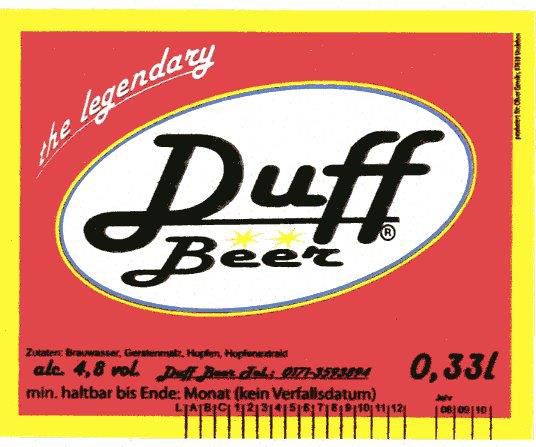Fans of cartoon, The Simpsons, may sit back and enjoy the taste of this cool, refreshing blog post about one of the more common trademark questions that trademark agents are asked. Why can a logo (called a figurative trademark) prevent us from using the same or similar words in a different graphical format?
The answer is that it depends on what is the dominant part of the trademark when you examine it, either visually, orally, or conceptually and how distinctive those dominant words are.
A recent German court case caught my eye on this question and there are similar principles applied in other EU jurisdictions. The German Federal Court of Justice (the “Bundesgerichtshof”, say that with a beer or two on you!) had to decide a trademark dispute involving a trademark for Duff Beer. Some of you may recognise the name, as it is a favourite of a certain Homer Simpson. What you may not have known is that Duff Beer is also a brand of beer marketed by Duff Beer AG (which is unconnected to Twentieth Century Fox Film Corporation’s, The Simpsons).
One of the questions faced by the court was whether a registered trade mark, which was registered as a logo that combined words and a particular graphical (figurative) get-up, could still be relied on if the trademark when used was depicted differently, so that only the dominant words remained the same?
The court looked mainly at a registered trademark with the words ‘Duff Beer’ in red on a blue, yellow and red oval background (a). It compared that to the mark as it was actually used, with the words printed on a sideways white oval on a red background (b).
In the cartoon series, Homer Simpson is seen on occasion to be drinking a beer, also called Duff beer from a red and white can, which you can see here.
Twentieth Century Fox issued these proceedings alleging infringement of their trademark rights. For some of you who wear drinking goggles, the marks might look identical, but to the court, Duff Beer AG’s trademark was registered in a graphical get-up which differed from the form actually used. Additionally, the altered form, as used, was quite close to the one used in the cartoon.
Twentieth Century Fox argued that the graphical get-up of the registered trademark and the graphical form in which it was used were so different that the trademarks must be found to have their own distinctive character and be different to each other. This would mean that Duff Beer AG would not be able to rely on its earlier registered trademark for Duff Beer to justify the actual use made of the trademark. That would not be genuine use. It argued that it was the graphical get-up that allowed the relevant public (that’s the average consumer who may have an interest in this type of product), who would be aware of the cartoon series, to associate the trademark in use with the Duff Beer from the cartoon series.
The court held that there were well established principles generally applied to decide the question of whether there is genuine use of a trademark when there are differences between the registered trademark and the form it is actually used in. It decided that these applied in this case too. It found that while it may be true that people who know the cartoon series may notice not just the word element, but also the graphic get-up in recognising the product, it could not limit the definition of the relevant public to just those who would know the sign from the cartoon series. Instead, the relevant public in this case was held to consist of the reasonably well-informed and reasonably observant and circumspect consumer.
The court held that this consumer would notice the verbal element as the distinctive part of both the registered trademark and the trademark as it was used. Therefore the use that Duff Beer AG put its registered trademark to was genuine.
This was important because although Twentieth Century Fox has trademarks relating to Duff Beer, these were applied for after the trademark registered by Duff Beer AG. The court ruling allows Duff Beer AG to continue to market its Duff Beer using the predominantly red and white logo get-up that may be familiar to beer fanciers who are also fond of The Simpsons.
The lesson for trademark owners is that while figurative trade marks are generally used to protect a particular get-up or logo device in a trademark, it can be just as effective to protect dominant word elements. This could be useful where a word mark might not be able to be registered because of a lack of distinctiveness or descriptiveness. In this way a figurative trademark can operate in the way that you might normally associate with a word mark. It also means that those looking to register a later trade mark should take due note of dominant elements of earlier figurative trademarks.
Message from TMR Fitzsimons Trademarks
If you have any questions about dealing with your trademark issues or other intellectual property matters call Michael Fitzsimons directly on +353 (0)41 9843534 for advice. And if you found this post useful, you can buy me a beer!


